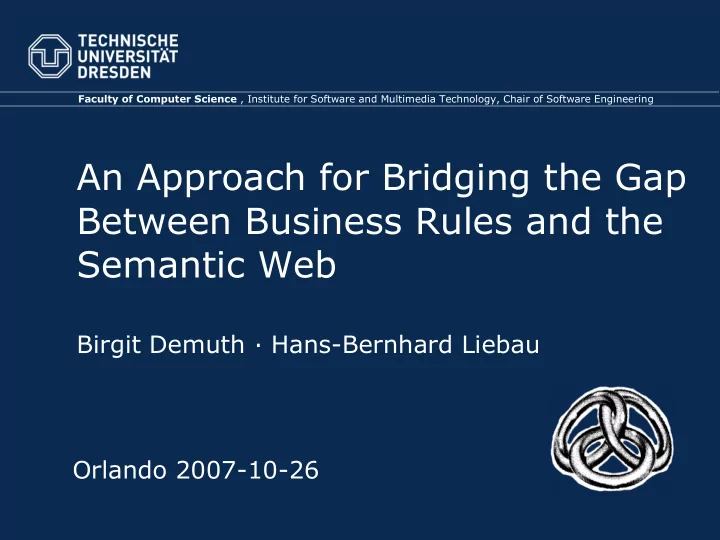

Faculty of Computer Science , Institute for Software and Multimedia Technology, Chair of Software Engineering An Approach for Bridging the Gap Between Business Rules and the Semantic Web Birgit Demuth · Hans-Bernhard Liebau Orlando 2007-10-26
Nature of the Task – Mapping SBVR • OMG Specification, since 2006 • Semantics of Business Vocabularies and Business Rules • essentially based on first order and modal logic • orientation on the language of business people Semantic Web (Vision, W3C Standards) SBVR • based on various logics • orientation on machine processing of logic-based knowledge ? Semantic Web Orlando, RuleML 2007-10-26 Birgit Demuth · Hans-Bernhard Liebau Slide 2 of 14
Content 1. Motivation 2. Source Language SBVR model driven context ● example ● 3. Targeting Semantic Web language selection ● (OWL, R2ML) 4. Mapping procedure ● examples ● 5. Summary and Outlook Orlando, RuleML 2007-10-26 Birgit Demuth · Hans-Bernhard Liebau Slide 3 of 14
SBVR in the MDA context – An Example for "Model Driven Integrity Engineering" (MDIE) – SemWeb SBVR expressive expressive to to power ↑ power ↓ to "MDA Big Picture" following [Schacher] Orlando, RuleML 2007-10-26 Birgit Demuth · Hans-Bernhard Liebau Slide 4 of 14
Example: Domain Model in SBVR – following [Baisley], fragments – Vocabulary employee ... manager Definition employee that manages others General concept employee Synonym supervisor employee 1 is under employee 2 Synonymous Form employee 2 over employee 1 Rules MC No Selfmanagement Rule Statement It is prohibited that an employee is a manager over the employe Orlando, RuleML 2007-10-26 Birgit Demuth · Hans-Bernhard Liebau Slide 5 of 14
Semantic Web Overview - RuleML - R2ML (REWERSE) - ... - W3C: SWRL proposal RIF (until 2009) standardizations finalized (since 2004) Semantic Web Stack (Version 2002) [Berners-Lee]; adapted Orlando, RuleML 2007-10-26 Birgit Demuth · Hans-Bernhard Liebau Slide 6 of 14
Splitting Transformation, Target Languages Orlando, RuleML 2007-10-26 Birgit Demuth · Hans-Bernhard Liebau Slide 7 of 14
Semantic Web Overview - RuleML - R2ML (REWERSE) - ... - W3C: SWRL proposal RIF (until 2009) standardisations finalized (since 2004) Semantic Web Stack (Version 2002) [Berners-Lee]; adapted Orlando, RuleML 2007-10-26 Birgit Demuth · Hans-Bernhard Liebau Slide 8 of 14
Mapping Procedure and Prototyping Manually creating Providing metamodels S T target document for used modelling languages (example model) • Eclipse Modelling Framework (EMF) Defining schematic Transformations • generalization of mappings mapping • currently about 20% of SBVR covered • Transformation tool: Together for Eclipse run Generating target document s t • validation, usage in future Orlando, RuleML 2007-10-26 Birgit Demuth · Hans-Bernhard Liebau Slide 9 of 14
Transformation Chain Orlando, RuleML 2007-10-26 Birgit Demuth · Hans-Bernhard Liebau Slide 10 of 14
Example: Mapping of Vocabulary SBVR OWL (ODM) Orlando, RuleML 2007-10-26 Birgit Demuth · Hans-Bernhard Liebau Slide 11 of 14
Rule Mapping 1. Integrity rules (in SBVR having modality, explicitly described) It is necessary that... r2ml::AlethicIntegrityRule alethic It is possible that... no mapping possible alethic It is obligatory that... r2ml::DeonticIntegrityRule deontic It is prohibited that... deontic It is permitted that... no mapping possible deontic 2. Derivation rules (in SBVR implicitly described) e.g. via closed definitions not considered here Orlando, RuleML 2007-10-26 Birgit Demuth · Hans-Bernhard Liebau Slide 12 of 14
Example: Deontic Rule to R2ML It is prohibited that an employee is a manager over the employee. deontic ¬ ∃ e 1 employee ∃ e 2 manager ( thing is thing (e 1 ,e 2 ) | employee over employee (e 2 ,e 1 ) ) <RuleBase externalVocabularyID=...> <ruleSet xsi:type="IntegrityRuleSet"> ... < integrityRule xsi:type=DeonticIntegrityRule> ... < quantifiedFormula xsi:type="ExistentiallyQuantifiedFormula"> < objectVariable classID="manager" name="e2"/> ... <logicalFormula xsi:type="Conjunction"> ... <logicalFormula xsi:type=" ObjectDescriptionAtom " classID= "employee-over-employee"> <objectSlot referencePropertyID= "employee-over-employee-role1"> <object> <objectTerm xsi:type=" ObjectVariable " name="e2"/> Orlando, RuleML 2007-10-26 Birgit Demuth · Hans-Bernhard Liebau Slide 13 of 14
Summary and Outlook • Conclusion – mapping approach is suitable (SBVR → Semantic Web) – prototype extensible (conceptually, EMF, Together QVT) – loss in expressive power (anticipated) • Vision – excellent opportunities for automating SBVR-specified business rules – by efficient transformer tools via the Semantic Web (OWL, RIF) Orlando, RuleML 2007-10-26 Birgit Demuth · Hans-Bernhard Liebau Slide 14 of 14
Example: Mapping of Vocabulary SBVR OWL (ODM) Orlando, RuleML 2007-10-26 Birgit Demuth · Hans-Bernhard Liebau Slide 15 of 14
Mapping Concept: SBVR FactType • Depiction following QVT (graphical syntax of the QVT relational language) • For element and attribute names see metamodels Orlando, RuleML 2007-10-26 Birgit Demuth · Hans-Bernhard Liebau Slide 16 of 14
Example: Domain Fact Type in SBVR graphically – role and placeholder linkage simplified – Orlando, RuleML 2007-10-26 Birgit Demuth · Hans-Bernhard Liebau Slide 17 of 14
Example: Domain Model in XMI ([Baisley], fragments) <xmi...> < esbvr:Thing xmi:id="employee-is-under-employee-fact-type"/> < esbvr:Thing xmi:id="employee-is-under-employee-sentential-form"/> ... < esbvr:Extension xmi:id="employee-is-under-employee-roles" element="employee-is-under-employee-role1..."/> < esbvr:Text xmi:id="t-employee-is-under-employee" value="employee is under employee"/> ... < sbvr:fact-type-has-role fact-type="employee-is-under-employee-fact-type" role="employee-is-under-employee-roles"/> <sbvr:fact-type-has-form-of-expression concept="employee-is-under-employee-fact-type" form-of-expression="employee-is-under-employee-sentential-form"/> <sbvr:representation-has-expression representation="employee-is-under-employee-sentential-form" expression="t-employee-is-under-employee"/> ... </xmi:xmi> Orlando, RuleML 2007-10-26 Birgit Demuth · Hans-Bernhard Liebau Slide 18 of 14
Source Metamodel: SBVR (EMF implementation, fragment) Orlando, RuleML 2007-10-26 Birgit Demuth · Hans-Bernhard Liebau Slide 19 of 14
Intermediate Metamodel: SBVR2 (fragment) SBVR fact types embedded into the context of typed nodes standing for noun concepts – thinner und deeper class hierarchy – transformation: code simplification, performance ↑ Orlando, RuleML 2007-10-26 Birgit Demuth · Hans-Bernhard Liebau Slide 20 of 14
Target Metamodel: ODM (EODM implementation, fragment) Orlando, RuleML 2007-10-26 Birgit Demuth · Hans-Bernhard Liebau Slide 21 of 14
Target Metamodel: R2ML (EMF implementation, fragment) Orlando, RuleML 2007-10-26 Birgit Demuth · Hans-Bernhard Liebau Slide 22 of 14
Recommend
More recommend